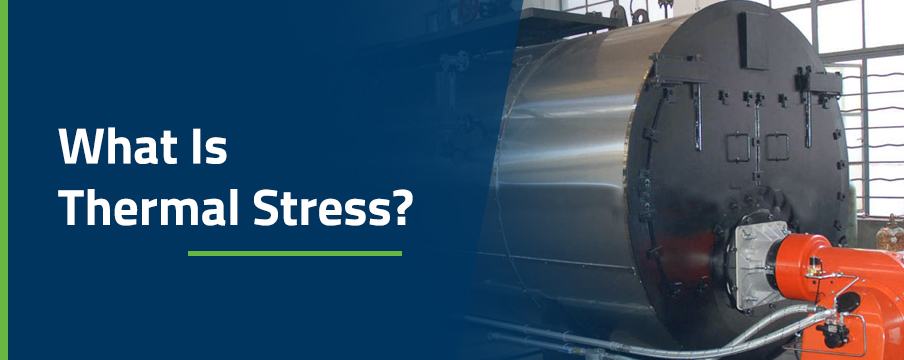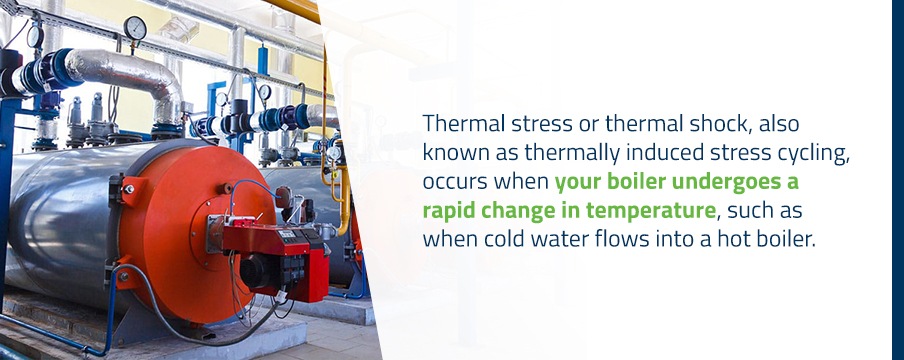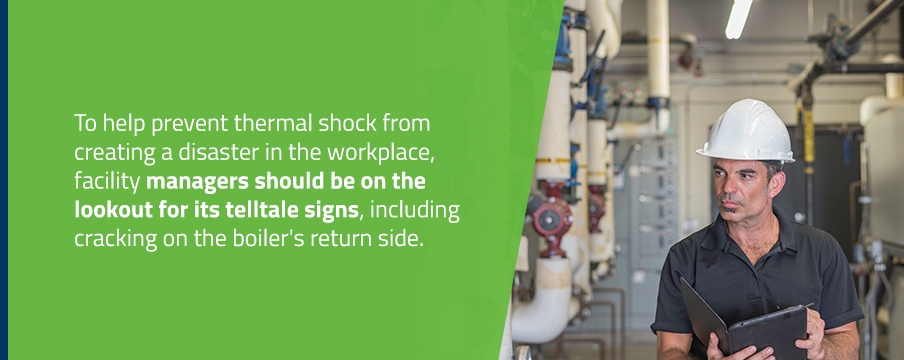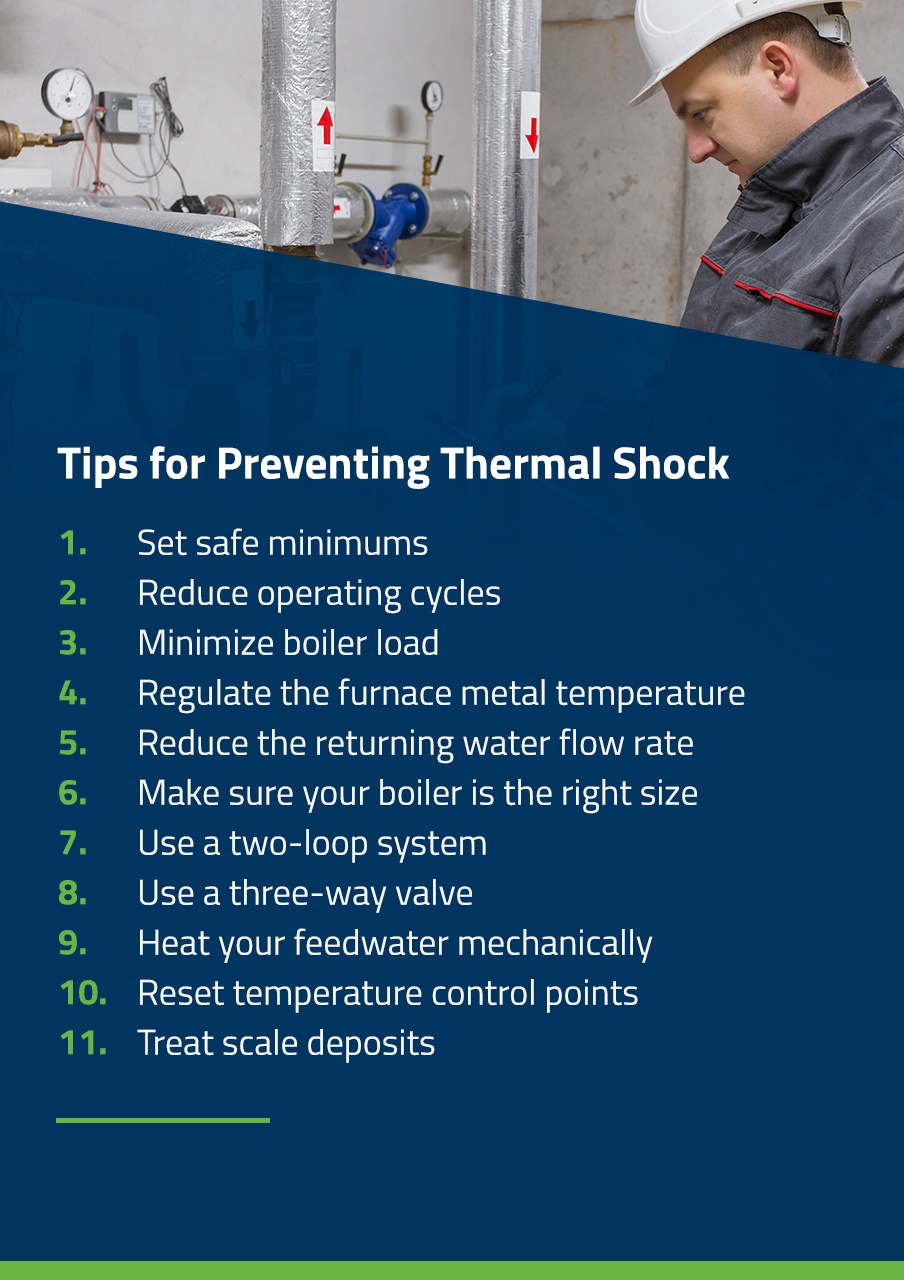
What Is Thermal Stress?
Steam boilers form the backbone of many different industries. They generate electricity for industrial operations, supply hot water for commercial and hospital laundries, heat water to precise temperatures for breweries and distilleries, provide steam for sterilization in pharmaceuticals manufacturing and help keep facilities productive and profitable. As of 2005, the latest year for which data is available, over 45,000 industrial and manufacturing boilers were hard at work across the United States.
But it’s important to take good care of a facility’s boiler to extend its lifespan, increase efficiency and avoid injuries. United States industrial operations see, on average, about 72 boiler and pressure vessel injuries a year, along with 12 fatalities a year. So a safe, functional boiler is vital.
One essential way to maintain a boiler properly is to manage and reduce thermal stress, or thermal shock. Reducing thermal stress helps make a boiler more energy-efficient, reduces its maintenance and repair needs and makes it safer and more reliable to operate.
But what is thermal stress, what causes it, and what steps can you take to prevent its occurrence in steam boilers? We’ll answer these questions in this guide.
What Is Thermal Shock in Steam Boilers?
Have you ever accidentally filled a cold glass container with a hot liquid, only to have the glass crack? Thermal stress in a boiler works in much the same way.

Thermal stress or thermal shock, also known as thermally induced stress cycling, occurs when your boiler undergoes a rapid change in temperature, such as when cold water flows into a hot boiler. The contrasting water temperatures cause the boiler’s furnace to become a different temperature from that of its outer shell, which is the larger area that holds the water and steam. That temperature difference then puts incredible stress on the metal. Thermal shock represents a serious safety issue in the workplace.
Under normal circumstances, when a boiler is operating, it is full of boiling water, and its metal is scorching hot. If cold water enters the hot boiler full of boiling water, it causes an extreme reaction. It’s important to note, though, that most thermal shock does not occur because of a single instance of temperature discrepancy in the boiler. It typically happens over time, in response to repeated temperature changes. The shock can occur over weeks, or it can occur over a substantially longer period.
Thermal shock typically occurs in places in the boiler where temperature differences are most significant. It often occurs near the back of the boiler, near the joints. Or it may occur near the furnace, where cold feedwater flows in.
Thermal shock can affect facilities in many different industries, including the following:
- Health care
- Brewing and distilling
- Oil refining
- Food processing
- Commercial laundry
- Pharmaceuticals manufacturing
- Automotive manufacturing
- Chemical manufacturing
- Textile manufacturing
- Pulp and paper manufacturing
But steam boilers in any industry can become susceptible to thermal shock.
How Thermal Shock Harms Your Boiler
What happens when hot and cold water come into contact in your boiler? The tremendous temperature difference causes the metal equipment inside the boiler — including walls, pipes, fittings, valves, tubes and tube sheets — to expand and contract rapidly.
During regular boiler operation, the metal may expand and contract as the overall temperature of the boiler water changes. But when this happens, all the metal in the boiler expands and contracts safely, at the same rate. With thermal shock, the parts of the metal exposed to cold water contract, while the parts of the metal exposed to hot water expand.
The expansion and contraction of the boiler equipment can have dire consequences. These changes may damage the boiler — weakening the metal, causing cracks and requiring expensive repairs or complete replacement. If left untreated, thermal shock can lead to a boiler explosion that causes severe injuries or even fatalities.

To help prevent thermal shock from creating a disaster in the workplace, facility managers should be on the lookout for its telltale signs, including cracking on the boiler’s return side. Facility managers should address the cracking immediately to prevent further damage or an explosion.
The Causes of Thermal Stress
Many causes can lead to thermal stress in boilers.
Sometimes, water that has flowed out of the boiler can return to the boiler after it has cooled off. When it returns, this cooler water mixes with the hot water still in the boiler. When this happens over and over, the metal inside the boiler is continually cooling and reheating. Other times, structural issues or water quality issues contribute to thermal stress.
Here are some explanations of the different factors that can cause thermal stress:
- Cold feedwater: Allowing high volumes of cold feedwater or boiler returns to flow directly into the boiler can cause thermal stress. Low feedwater and boiler return temperatures are among the main causes of thermal stress, though they arise for various reasons.
- Too much steam: One culprit is often the production of too much steam, which frequently occurs when the boiler is too large. When the boiler produces too much steam, the cooled steam can flow back into the boiler and mingle with the hot water.
- Scale deposits: Another common culprit is the buildup of scale deposits on the boiler’s metal surfaces and components. Scale deposits occur when minerals and impurities precipitate out of the water and land on the boiler’s inner surfaces. Over time, these impurities build up as scale deposits. The scale deposits then act as insulators, trapping heat in some regions of the metal and causing uneven heat distribution.
- Excessive cycling: Excessive cycling can cause thermal stress in your boiler because it increases the number of times cold water must flow into the boiler. One leading cause of excessive cycling is an oversized boiler. A boiler that is too large quickly produces the desired steam, shuts down, and then starts up again to meet the next demands.
- High boiler load: The boiler load is determined by a combination of the temperature difference and the rate of incoming cold water flow. A high rate of feedwater flow can exacerbate differences in temperature and contribute to thermal stress.
- High boiler pressure: High boiler pressure leads to high temperatures. And high boiler water temperatures, in turn, lead to larger temperature discrepancies between boiler water and return water and increase the likelihood of thermal shock.
- Burner firing rate: Remember that thermal shock can result when the metal temperature of the furnace differs too radically from the metal temperature of the boiler’s outer shell. Burner firing rate affects that temperature difference. A high-firing furnace will become hotter than a low-firing furnace, and it can put the boiler at greater risk of thermal shock if the outer shell stays much cooler. Low-fire stresses are generally only 30% to 35% as severe as high-fire stresses.
- Electrical load shedding: In this scenario, a facility’s air handling units shut down for several hours, perhaps at night, to reduce electrical demand. But when this happens, the water cools down substantially. When the system restarts, large volumes of cold water flood the boiler, increasing the risk of thermal shock.
In addition to these causes, a few different boiler configurations can make boilers more susceptible to thermal stress:
- Night setback and weekend shutdown modes: These modes can sometimes lead to thermal stress. When the pumps come back on after the long rest, they deliver cool water to a still-hot boiler.
- Dual temperature changeover: Systems with dual temperature changeover can become susceptible to thermal stress when they try to change from cooling mode to heating mode. During the changeover, the pipes may fill the hot boiler with cold water.
- Heat pump loop designs: Heat pump loop systems typically require a boiler to supply additional heat, but an improper configuration of the system can lead to thermal shock. Heat pump loop systems usually supply heat at much lower temperatures than the standard operating temperature of a boiler, so the mixture of the two types of water can stress the boiler.
- Outdoor reset designs: Outdoor reset designs are designed to save energy by adjusting the boiler water temperature in response to outdoor temperatures. In cold weather, the boiler water temperature is higher, and in warm weather, the boiler water temperature decreases to compensate for the increase in outdoor temperatures. The problem arises when the system then returns water to the hot boiler. The returned water often has a temperature below the manufacturer’s recommended temperature, and it puts the boiler at risk of thermal shock.
- Temperature control points: In some cases, boilers have temperature control points that help increase energy efficiency and reduce the boiler’s environmental impact. But the temperature control points cool the boiler’s water, increasing the risk of thermal shock and compromise of the boiler’s structural integrity.

To prevent thermal shock, you can try a few different strategies
- Set safe minimums: Set a minimum water return temperature to the boiler and a minimum water flow rate through the boiler. These parameters will help reduce stress on the metal.
- Reduce operating cycles: To help prevent thermal shock, try minimizing the number of operating cycles each day. Reducing the operating cycles also effectively reduces the number of times you require your boiler to heat water. And fewer new demands on the boiler mean fewer chances for hot and cold water to mingle.
- Minimize boiler load: Companies can work to reduce the demands on the boiler, often by creating a separate boiler loop with its own circulator. This design helps keep the water flow constant and allows the boiler to handle fluctuations in water temperature.
- Regulate the furnace metal temperature: Ideally, the metal of your boiler’s furnace would remain at a temperature very close to that of the boiler shell. Keeping the furnace’s metal at a consistent temperature by controlling the heat helps reduce the risk of thermal shock.
- Reduce the returning water flow rate: Decreasing the returning water flow rate in your boiler can help reduce the risk of thermal shock. A minimal water flow rate reduces the chances that a substantial surge of cold water can flow back into your boiler and shock the metal.
- Make sure your boiler is the right size: Choosing the right-sized boiler for your facility is critical. An oversized boiler will cause excessive cycling, which in turn can lead to thermal shock. But a boiler sized specifically for your needs will cycle appropriately while still producing the steam your operations require.
- Use a two-loop system: Using a boiler system with two loops helps keep warm and cold water separate. Sophisticated systems have more than one loop — a boiler loop that remains at a consistent flow rate and high temperature, and a building system loop in which temperature and flow rate vary. Or they may have a computerized system that helps adjust and control the water temperature by diverting a calibrated amount of hot water into the cold water.
- Use a three-way valve: One common mechanism in a two-loop system is a three-way valve that can help reduce the flow of cold water into the boiler. If the temperature in the loop becomes too cold and poses a risk of thermal shock, the three-way valve can close off the loop and allow hot water from the boiler to pump directly into the return feed. This hot water raises the temperature of the water flowing into the boiler to safe levels.
- Heat your feedwater mechanically: To heat your feedwater, you can use a steam or electric heater. Heating your feedwater helps minimize dramatic temperature differences in your boiler system.
- Reset temperature control points: In some cases, a simple reset of the temperature control points designed to increase energy efficiency can reduce the risk of thermal shock. In other cases, the boiler system will need to undergo more extensive alterations if the facility manager wishes to preserve energy efficiency while protecting the boiler.
- Treat scale deposits: For treating scale deposits in your boiler, chemical cleaning is a useful option. This process treats your boiler water with chemicals that disperse dissolved minerals and particulates to prevent them from precipitating out and forming clumps of scale buildup. Treating scale deposits has the additional benefit of making your boiler more efficient by reducing its fuel consumption, so this solution is practical and popular.
-
Contact Chardon Laboratories for Help With Thermal Stress in Your Boiler
If you have questions about boiler thermal stress, Chardon Labs can help. We provide boiler water treatment that helps reduce scale buildup and reduces the risk of resulting thermal stress. We offer both boiler water treatment equipment and boiler treatment chemicals to help keep your boiler running safely and efficiently, and we can customize our treatments across a range of industries to meet your facility’s specific needs.
Our treatment services are trustworthy, technically reliable and cost-effective. They help save you money by reducing the need for boiler repairs and replacements, and they help keep your facility safer by reducing the risk of thermal shock and decreasing the likelihood of a boiler explosion.
Contact us today to learn more.




